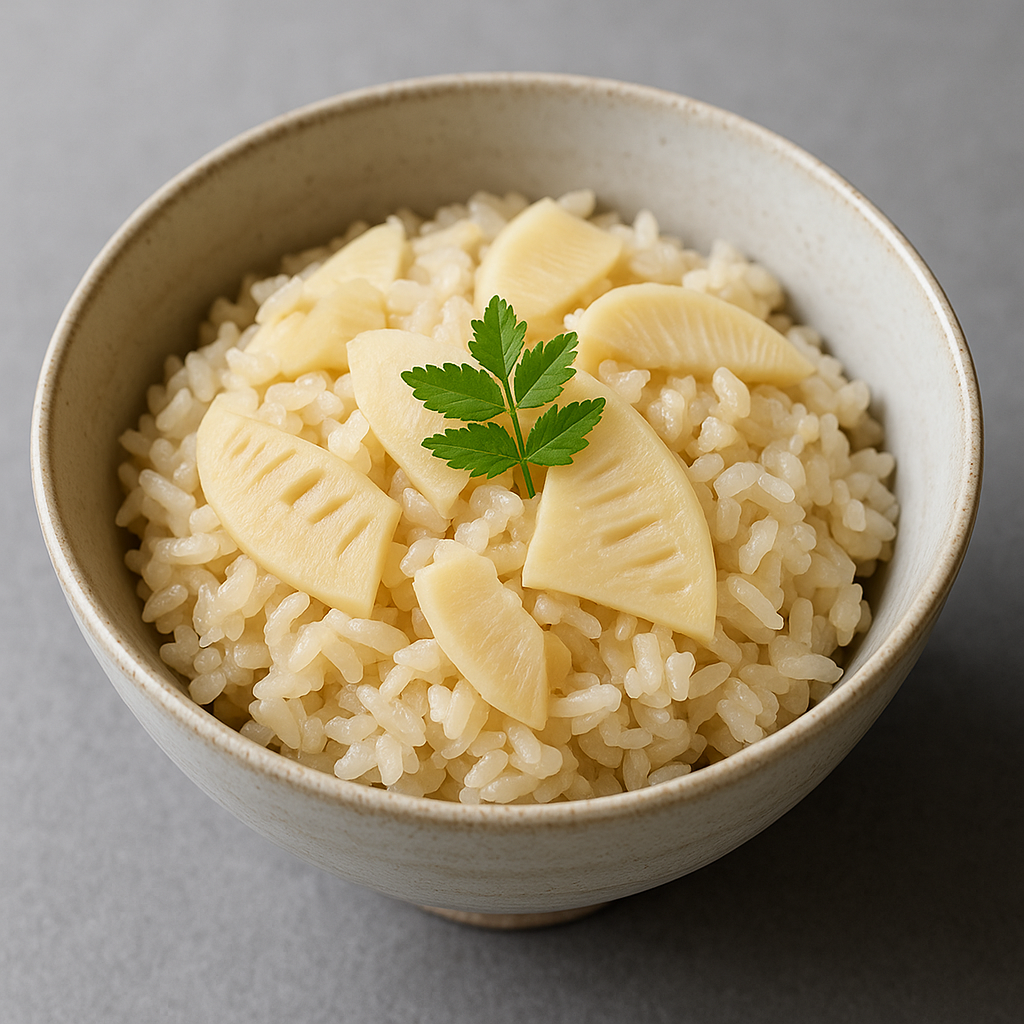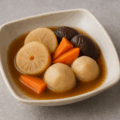たけのこご飯(宮城)の特徴
春の香りと歯ざわり、だしが染みる一椀
旬のたけのこをたっぷり使い、昆布だしとしょうゆの香りをやさしく含ませて炊き上げます。しゃきっとした歯ざわりと、噛むほどに広がるうま味が春らしさを運びます。
油揚げでコクを、木の芽で香りを添えます
油揚げのうま味がご飯全体に行き渡り、後味は木の芽や三つ葉で軽やかにまとまります。色よく仕上げるため、しょうゆは控えめにしてだしで風味を立てます。
たけのこご飯(宮城) レシピ
材料(2〜3人分)
- 米 … 2合(洗って30分浸水・ざる上げ)
- ゆでたけのこ(穂先は薄切り/根元はいちょう切り) … 200g
- だし(昆布または昆布かつお) … 適量(2合の目盛りまでの総量)
- 薄口しょうゆ … 大さじ2
- みりん … 大さじ1と1/2
- 酒 … 大さじ1
- 塩 … 小さじ1/4〜1/3
- 木の芽または三つ葉 … 適量(仕上げ用)
作り方
- たけのこは食べやすく切る(穂先は薄く、根元はやや薄めのいちょう切り)。
- 計量カップで薄口しょうゆ・みりん・酒を合わせる。炊飯釜に米を入れ、合わせ調味料を加え、だしを2合の目盛りまで注ぐ(塩で味をととのえる)。
- たけのこを上に広げてのせ、混ぜずに普通炊きで炊く。
- 炊き上がったら10分蒸らし、底からさっくり切るように混ぜる。器に盛り、木の芽(または三つ葉)を散らす。
シェフのワンポイントアドバイス
- 調味料も水分に含まれるため、液量は「調味料+だし」で合数の目盛りちょうどに合わせます。
- 具は混ぜ込まず上にのせて炊くと、べたつきを防いで香りよく仕上がります。
- 市販の水煮たけのこは、さっと下ゆですると独特の匂いがやわらぎます。
- 色を淡く保ちたい場合は薄口しょうゆを主体にし、香りづけに濃口を小さじ1ほど加えても良いです。
栄養価(1人分の目安/全量の1/3)
- エネルギー … 約380kcal
- たんぱく質 … 約8g
- 脂質 … 約3g
- 炭水化物 … 約80g
- 食塩相当量 … 約2.0g
歴史
春の山の恵みを生かす炊き込みご飯
山間部や里山のたけのこを持ち寄り、家庭でだしとしょうゆでさっと炊く春の行事食として親しまれてきました。素朴ながら季節感のある一品です。
宮城はたけのこの有名な産地の1つ
県内ならばどこでもたけのこは採れるので、春になると様々なたけのこ料理が作られます。商業用だけでは無く、たけのこ掘り体験も可能となっています。
家ごとの味の幅
木の芽・三つ葉・刻み昆布など仕上げの香りや、薄口・濃口の配合に家ごとの個性があり、地域の味わいが反映されています。
English Version
Features of Takenoko Gohan (Miyagi)
Spring aroma, crisp bite, and dashi-soaked grains
Packed with seasonal bamboo shoots and gently seasoned with kombu-forward dashi and soy sauce, this rice dish delivers a clean snap and savory sweetness that tastes like spring.
Fragrant finish with kinome or mitsuba
Keep soy sauce modest and let the dashi lead; garnish with kinome (sansho leaves) or mitsuba for a light, aromatic finish and bright color.
Recipe – Takenoko Gohan (Miyagi)
Ingredients (Serves 2–3)
- Japanese short-grain rice … 2 rice-cooker cups (washed, soaked 30 min, drained)
- Boiled bamboo shoot (tips thin-sliced; base in half-moons) … 200 g
- Dashi (kombu or kombu–bonito) … to the 2-cup fill line in the pot (total liquid)
- Light soy sauce (usukuchi) … 2 Tbsp
- Mirin … 1½ Tbsp
- Sake … 1 Tbsp
- Salt … ¼–⅓ tsp
- Kinome or mitsuba … to finish
Directions
- Cut bamboo shoot as noted: tips very thin; base into slightly thin half-moons.
- In a measuring cup, combine light soy, mirin, and sake. Add rice to the cooker, pour in the seasonings, then add dashi up to the 2-cup line; adjust salt.
- Spread the bamboo on top without mixing. Cook on the regular setting.
- Steam 10 minutes after the cycle ends, then fluff with a slicing motion from the bottom. Serve and garnish with kinome or mitsuba.
Chef’s Tips
- Seasonings count toward liquid—measure seasonings + dashi to the rice line for proper texture.
- Keeping toppings on top prevents mushiness and preserves aroma.
- Briefly blanch packaged boiled bamboo to mellow any residual aroma; fresh bamboo should be pre-boiled with rice bran before use.
- For a pale finish, rely on light soy; you may add ~1 tsp dark soy for fragrance if desired.
Nutrition (per serving, ~⅓ of pot)
- Energy … ~380 kcal
- Protein … ~8 g
- Fat … ~3 g
- Carbohydrates … ~80 g
- Salt equivalent … ~2.0 g
History
Spring mountain bounty in a pot
Families have long welcomed spring by simmering freshly dug bamboo shoots with dashi and soy for a simple, seasonal rice dish.
Miyagi as one of Japan’s noted bamboo-shoot regions
Across the prefecture, bamboo shoots inspire many home dishes each spring. Beyond commercial harvests, digging experiences are offered in some areas.
Household variations
Finishes like kinome, mitsuba, or shredded kombu—and the balance of light vs. dark soy—vary by household, reflecting local tastes.



何でも質問してください!